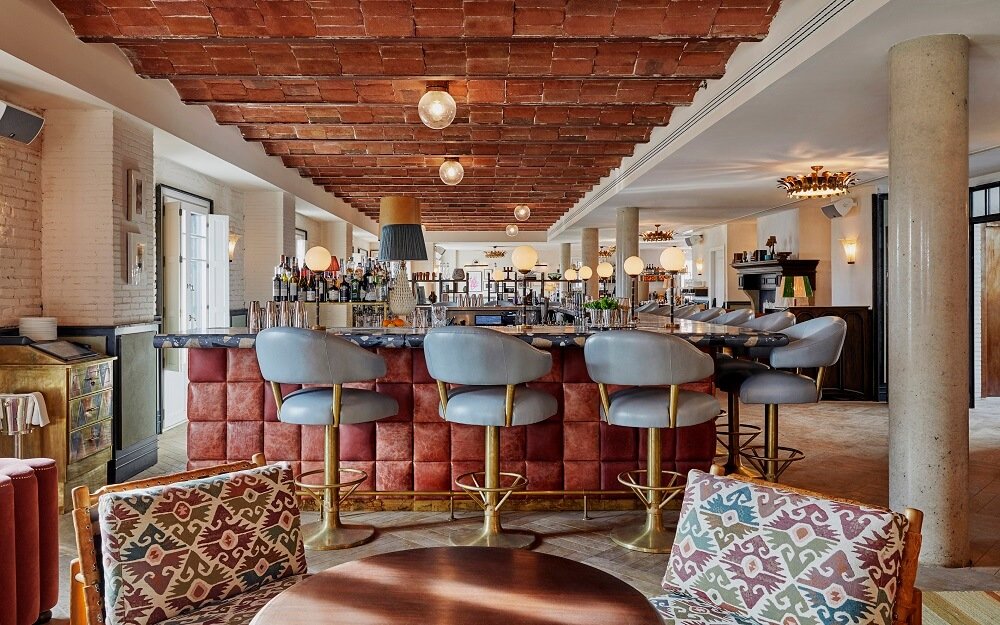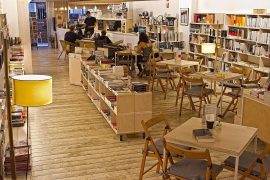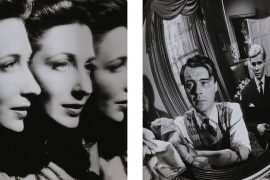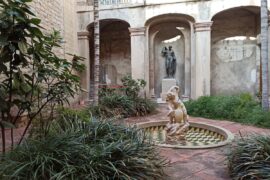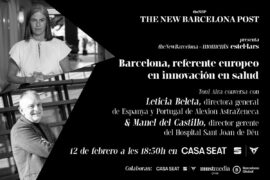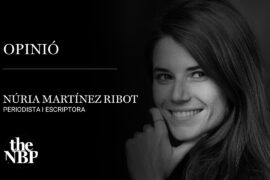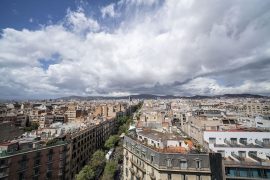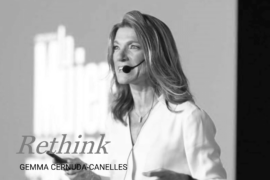Barcelonans have always been good at associating for the most diverse reasons. Along with centennial social clubs that bring together the elites of the city, new projects of economic, social or recreational clubs flourish that promise exclusivity, discretion, privilege and a kindred environment. The backdrop is still the enduring English [gentlemen’s] club, although the course of time has softened the formalities, opening the membership to women and leading to the emergence of clubs that attempt the balancing act of being exclusive without excluding.
During the last decades there has been a certain attempt at revamping the concept of the traditional private club. One of the most conspicuous was the Círculo Condal, promoted by Juli Capella and Quim Larrea, an experiment forged in the heat of pre-Olympic euphoria. The intention was to modernise the concept of a British club by converting it into a cultural and recreational club, but it survived a short time. Today it hosts the offices of the Vila Casas Foundation on Casp street.
Now, however, it seems that things are getting serious. The revival of the idea of the private club, until recently apparently outdated, is not a local phenomenon. In London, clubs are flourishing, like 5 Hertford Street,which opened in 2012 and which now has over 3,000 membership candidates on the waiting list thanks to its reputation as the best place for networking in the UK capital. Both 5 Hertford Street and the Groucho, another London club, are readying their landing in New York, in a process of expansion that until recently seemed untimely. In Madrid, places like Matador, Alma—a ladies’ club, although they’ll admit “some good men” (sic)—and other more posh clubs, like Argo, Nuevo Club or La Gran Peña, are all in good health. The traditional exclusive Círculos are facing new competitors whose consolidation is yet to be substantiated…
Through the large window overlooking Diagonal Avenue, you can see the traffic of the city from a room where reigns a proverbial calm. The members refer to the room as “the fish tank,” alluding to the usual presence of big fish. Since its inauguration in 1856, the Círculo Ecuestre (Balmes 169 bis) brings together many of the most influential personalities of Barcelona’s social and economic elite, with a profusion of illustrious family names amongst its membership. The most exclusive private club in Barcelona is located in an elegant modernist palace designed by the architect Juan José Hervás Arizmendi in 1910, the Pérez Samanillo house, where the Círculo moved in 1950. It previously had other settings, in Sant Pau street off the Rambla de Santa Mònica, in Plaça de Catalunya and in Passeig de Gràcia. The latter was confiscated and destroyed by anarchists during the Civil War. It is defined as “a private, select, cosmopolitan business club where leisure and business, good food and exercise combine perfectly.”
The Equestrian Circle has reciprocal agreements with over 180 private clubs on four continents that can be accessed by showing a presentation card. It has up to nine rooms for events and meetings, as well as a restaurant, a gym, a small pool and an annex building where there are 16 rooms where club members or their guests may be accommodated. The Círculo Ecuestre regularly invites prominent personalities, organises gastronomic activities and group travel for its members.
To join the club, you must acquire a title for a nominal value of €4,000, plus €5,000 as the joining fee. The monthly fee is €93. Companies can also join the Círculo, acquiring four titles and paying €12,000 in entry rights. A total of €28,000 that allows registration of 2 to 8 members. In its eagerness to rejuvenate the average age of its members, the Circulo offers advantageous conditions for children or descendants of active members. Regarding protocol, a suit and tie are required inside the facilities, although at certain times the dress code may be relaxed.

This is the oldest private club in Spain that maintains its original setting. Although it shares facilities with the Teatre del Liceu, the Círculo del Liceo (La Rambla 65) is completely independent of the opera house. It disputes the title of the most exclusive of the city’s private clubs with the Circulo Ecuestre, although its activities focus on social and cultural life rather than on business and economy.
The Círculo del Liceo has about 800 members, of which approximately 60% are men and 40% women. It should be remembered that until the turn of the century the club’s bylaws forbade the membership of women. The average age is about fifty, and the fees depend on a scale of age, with corporate fees and for those who only expect to reside in Barcelona for up to 3 years. It is the only club of those consulted that refuses to make membership fees public. On the other hand, to become a member you must have the signature of four current partners that endorse the incorporation, in addition to having the subsequent approval by the Board of admissions of the club.
Its members enjoy a collection of elegant rooms, a conference room, a library, a restaurant and various services in one of Barcelona’s emblematic buildings, the Gran Teatre del Liceu. They have reciprocal agreements with a hundred clubs worldwide, and its estate includes a valuable collection of modernist works of art.
Inaugurated in 1847, just six months after the inauguration of the Gran Teatre del Liceu, it is still central for the social and cultural life of the elites of Barcelona and Catalonia. They organise lectures on opera, guided visits to entities and exhibitions, luncheon-talks with experts in current affairs, wine tastings and chamber concerts, among other activities.

Hedges Club (Balmes 220) recently opened officially. It is a franchise of a Great British institution, Hedges & Butler, whose history dates back to 1667 when Edmund Harris founded one of the oldest wine and spirits business which would eventually become a private club. The most famous of the British, Spanish, Japanese or Portuguese royalty frequented it in its golden age in the 19th century, and among modern day clients are many celebrities like Sharon Stone, Mick Jagger, Penélope Cruz, Arnold Schwarzenegger or Scarlett Johansson, to name just a few.
Its promoter, Youcef Aden, who headed the London parent of which he was a senior partner, has decided to open in Barcelona. He also has plans to open in Madrid and other European capitals. He has picked out a location at Balmes, 220 for the club and is opening its doors initially to about 250 members, aiming to reach 400, mostly from the business, managerial and creative worlds. The venue has three rooms: Regent (business), Burlington (relax) and the Carnaby Bar, as well as the Hedges Tea Club, a gastronomic space that is also open to ordinary mortals. Inside, you can have any premium drink and breakfast from eggs Benedict to crepes, as well as lunch or dine a repertoire of dishes that prioritise product and presentation (creams, salads, caviar or Wagyu meat).
The use of mobile phones and electronic devices is banned in the Burlington room, in accordance with the rules any British clubs that prides itself. If you get past the selection process (they are looking for influential people, although they claim to veto politicians), the monthly fee is €75 and includes a bottle of champagne every month. Hours are expansive, from 8 in the morning to 3 at night, and among the complementary services offered are concierge, accounting, tax and legal advice, as well as renting cars like Rolls or Bentleys for special occasions.

The Wild Bunch (Espinoi, 8-10), a business lounge created by businessman and sports consultant Uri Bueno, has also recently started operations. Clearly inspired by British style, with an informal name that pays tribute to Sam Peckinpah’s western, it is a cosy space decorated according to English standards, with de rigueur Chesterfield sofas, pool table, library, cigar bar, a terrace for smokers and even butlering.
The selection of members is carried out personally by Uri Bueno, whose business office is housed at the same location. There are currently just over fifty members, and the numerus clausus will be around the hundred-mark. A place that aims to create a small ecosystem that encourages networking and that brings together members who can also share recreational activities, from talks with speakers of recognised prestige to a members’ domino league, through film sessions in the cinema room, gastronomic tastings or activities outside the club.
The monthly fee is €100 for individuals and €300 for businesses. They also have exclusive private offices with prices starting at €480 per month.
This hotel and private club for creative professionals, which belongs to the eponymous international chain, opened its doors less than two years ago. Soho House was first established in London in 1995 by Nick Jones, and the formula has expanded to 18 venues in the most attractive capitals of Europe and North America: Berlin, Chicago, New York, Los Angeles, Amsterdam…
The Barcelona club (Plaça del Duc de Medinaceli, 4), whose opening required an investment of 60 million euros, combines a luxury hotel and a social club, and is located in the Gothic quarter, overlooking the port and with facilities that include a cinema, a gym, a spa, the social club and restaurants (the one on the ground floor, Cicconi’s, is open to the general public). To become a member, the owners require one condition: you be in a creative profession or have a creative spirit. There are different types of membership depending on age and whether you want to use the services of one or all the clubs in the chain, so the fees range between €750 and €1,800 per annum.
The first Soho House was established in London: a concept of a private club that did not neglect the slightest detail. Since then, the Soho House group has been expanding successfully. Berlin, Miami, New York, London or Chicago are some of the locations of these private clubs that house all kinds of facilities within the same building to facilitate their members’ leisure and business matters.
As at all the Soho Houses the world over, you cannot talk on the phone or take pictures in the private areas, and the dress code bans ties for men and jacket suits for women. All very casual, but very stylish.
The decoration, with which they had Lázaro Rosa-Violán’s help, is one of its main attributes. To access the Soho spas, you do not have to be a club member. The one in Barcelona is inspired by a traditional Spanish pharmacy. This relaxing place has soundproofed treatment rooms, comfortable manicure and pedicure armchairs and a heated pool…
In the gym (members only), the training and boxing rooms, the house ride classes (the latest mode of spinning), the yoga area, the steam room and the juice bar stand out.
OneOcean Club was established with the intention of gathering the distingué super-yacht crowd who moor in the renewed Port Vell marina, as well as the city’s social elite. The privacy of the club is in fact obliged by the fact that it is in a restricted access area since the marina was remodelled. But becoming a member is as simple as registering free on its website. There are no fees but you do have to get the endorsement of a member.
It is divided in two main areas: one is the restaurant, under the direction of chef Francisco Díaz, and the other the OneOcean Bar, a cocktail bar that was classed Best Bar in the World in the “Restaurant & Bar Design Awards.” The bar offers an idyllic space to enjoy drinks lulled by the reflections of the sea and the play of lights and shadows of its architecture.
Not clubs, but almost
There are also locales in Barcelona that, without actually functioning as private clubs, play with the appearance of a certain secrecy and exclusivity to attract their clients. Their references are the speakeasies, a product of the American Prohibition (1920-1933), whose application had side effects such as the flowering of contraband and its associated mafias. As a reaction to Prohibition arose establishments that were accessed with passwords and were hidden in warehouses or camouflaged under the guise of other businesses. In New York it is estimated that there were 10,000 of them during the Prohibition. Some were truly luxurious, with live musical acts and service bells, while others were really sleazy. Entry for their clientele was like that of a private club. Some of the original speakeasies still survive in New York as a tribute to an era, and the model has been copied all over the world despite the absence of prohibition. Thus, the Paradiso cocktail bar (Rera Palau 4) is hidden behind the cold-store of a pastrami sandwich bar in the heart of Barcelona’s Born district. The sandwiches are not just a simple cover mind you, and are well worth trying, both in the tiny bar at the entrance and inside, where you can also order a la carte. When going through the door of the cold-store, you walk into a luxurious cocktail bar with outstanding creativity in the presentation of its beverages. It is not strictly a secret place, as the frequent queues at the entrance testify, but what many of its regulars do not know is that it also has a sumptuously decorated secret chamber accessed through an opening in the wall in the toilet in its storeroom, only accessible to those who rent it for private events.

In the store-room of Javier de las Muelas’ classic Dry Martini cocktail bar (Aribau 162) is the Speakeasy restaurant, a gastronomic locale similar to the clandestine bars of Chicago and New York in the 1920s. The store-room maintains an atmosphere that plays with the anonymity and luxury of that which is concealed. A reserved place, intimate and pleasant, with an excellent gastronomic offer.
More roguish Nevermore (Cera 17) is a restaurant hidden in the heart of the Raval district, run for over four years by the ineffable Alfonso de la Mota, a chef who arose in the art world and then trained at the Bulli. A place where cooking workshops are organised every Tuesday, and where you can only dine by booking. It lacks a menu as Alfonso makes up the bill of fare tailored to the needs and budgets of his guests. He himself will buy the ingredients from the nearby Boqueria market, and cooks in an open kitchen, in full view of the diners. It is a large space, decorated with recycled objects with scallywag exquisiteness, and provided that Alfonso is in a good mood you can extend the postprandial until the early hours in an environment that evokes the Berlin underground.
Smoking in a legal limbo
In diametrical opposition to the distinguished institutions that open this article, in recent years there have also flourished another kind of private club in the city. These are the associations of marijuana users, which exist in a certain legal limbo, but of which some two hundred have opened in the city. Understated and, by law, without any signs outside, membership usually requires the recommendation of at least one member, and the signing of statutes that safeguard the legal liability of the promoters before potential legal problems. Although many are precarious, others are spacious, modern and luxuriously decorated, and include fillips such as live musical acts, film screenings, bar service, pool or foosball tables and video-game rooms.
There are also classical tobacco smokers clubs. The best is the El Palace smokers’ club, located in what had been the coal cellar of the eponymous hotel, and the annex of the Blueman Cocktail Bar. In this sumptuous room, the passion for cigars is shared in an intimate, elegant and exclusive environment for lovers of Havana cigars. Next to the club is the cigar cellar, where members have at their disposal a selection of the best marques, and personal lockers for those members who wish to keep their cigars in peak condition. A club that perhaps Groucho Marx, a lover of cigars and who was also a member of the Friar’s Club in Beverly Hills, a private club for actors in the golden years of Hollywood. He decided to resign his membership, and sent a wire that read: “Please accept my resignation. I don’t want to belong to any club that will accept people like me as a member.” It was his particular interpretation of Russell’s paradox, but that is another story.

